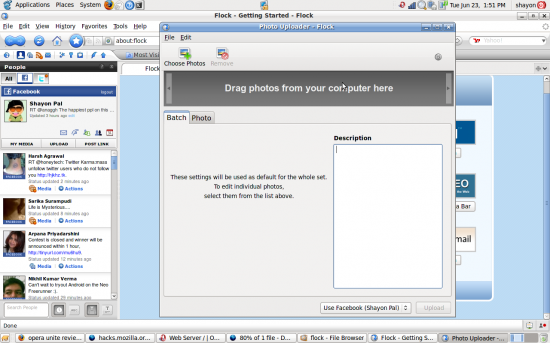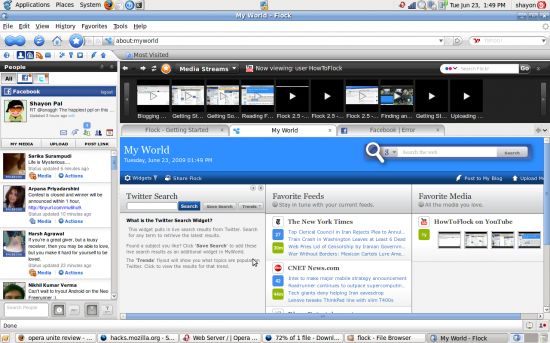Flock 2.5 is an open source browser, scheduled around the Gecko rendering engine that takes off at a good starting point: Mozilla Firefox. While it is built on Mozilla’s Firefox codebase, it tends to specialise in providing social networking and Web 2.0 facilities built into its user interface. With the Firefox base, Flock has incorporated new modules and has improved some aspects like graphics (three-dimensional icons) and new features like sharing bookmarks online, an integrated tool for creating and maintaining blogs, etc, while maintaining what made Firefox successful in the first place—extensions, lockout of automatic pop-ups, etc.
What’s the hype all about?
Flock is designed to streamline how you interface with social networking sites, RSS and media feeds, and blogs. Because it’s built on Firefox 3, its behaviour will seem familiar and it supports most—but not all—Firefox extensions. And yes, the ‘awesome bar’ is part of the latest version.
The social media add-ons are apparent from the start, though. The ‘My World’ tab—set as your home page by default—is devoted to collating your favourite stuff in one single view. It’s made up of a series of widgets that you can customise to display content from video and photo sites, RSS feeds, saved searches from Twitter and useful bookmarks.
How is a ‘social Web browser’ different?
While support from Twitter and Facebook had been present in Flock right from its inception, the browser now allows you to search the Twitter timeline and also keep them in History so that you can access them as and when you wish. Now, this is a very nifty feature because it lets you stay on top of trending topics on the micro-blogging network. Another great and useful feature is the automatic shortening of URLs that are shared on Twitter.
For the first time, Flock has integrated Facebook chat within the browser. While the side bar sits pretty, at the left of the browser, you can keep sharing content with your contacts while reading the latest news on Google reader or playing Scrabble on Yahoo Apps. All you need to do is stay logged into the Facebook network. What else? If you find something interesting while browsing the Web, all you need to do is drag the content and drop it on the side panel panel to share it with the world.
Speaking of drag-n-drop, Flock enables you to drag and drop content from any website on to the sidebar and share it with your contacts. To make life easier still, another new feature called FlockCast lets you automatically send an update to Facebook when you perform an action on another site. So, if you use the built-in functions to add a post to your blog, upload a photo to Flickr, a video to YouTube or a status message to Twitter, you can get it instantly echoed on Facebook. Right now, only Facebook is supported as a destination, but it’s a nice idea that could get much more useful if more services are supported in future Flock updates.

So, why isn’t everyone around me using Flock?
Flock can, any day, be used as a normal Web browser—the way you might use Mozilla Firefox and Epiphany for your daily surfing needs. However, it becomes a little inconvenient, with less screen space allowed by Flock for browsing, unless you are one of those rich kids who can’t think of anything below the 21-inch plasma monitors with super-high resolutions. The ugly and very bright sidebar, which is supposedly the strength and USP of the browser, actually makes browsing very cumbersome.

Moreover, while even Twitter can make you go bonkers with information overload, a complete browser with such heavy social functionalities built in, is definitely not meant for those with serious work to do, where one needs to remain focused. Even if you happen to be a social-media junkie, unless you have a lot of free time, you’ll always find yourself wanting to go back to whatever browser you are using.
Tip: There are a few Firefox plug-ins (like FireShot) that do work with Flock, but are not available for download. So, you can copy the Firefox’s settings folder into that of Flock to get as many plug-ins as possible. However, in case some are not compatible, you will have to disable them yourself.
Tip: There are a few Firefox plug-ins (like FireShot) that do work with Flock, but are not available for download. So, you can copy the Firefox’s settings folder into that of Flock to get as many plug-ins as possible. However, in case some are not compatible, you will have to disable them yourself.
- Tight integration with various social media networks like Orkut, Facebook, Twitter, Flickr, YouTube and many more.
- ‘My World’ features an iGoogle-esque homepage that shows the latest updates on your social connections every time you start the browser.
- Can be integrated so that you get notified of and can reply to new e-mails on GMail and Yahoo Mail, right on the browser.
- Has the heart of Mozilla Firefox, the most used (and abused) open source browser that’s fast, reliable, feature-rich and secure.
- My personal experience says Flock leaks less memory than Mozilla Firefox.
And the cons:
- Eats up a lot of screen real estate (the sole reason why I’d never use Flock, despite being a social media enthusiast myself).
- The colour schemes are too bright to let you concentrate on the contents of the websites you might be visiting.
- Not as many plug-ins are available for Flock as for Firefox.









































































